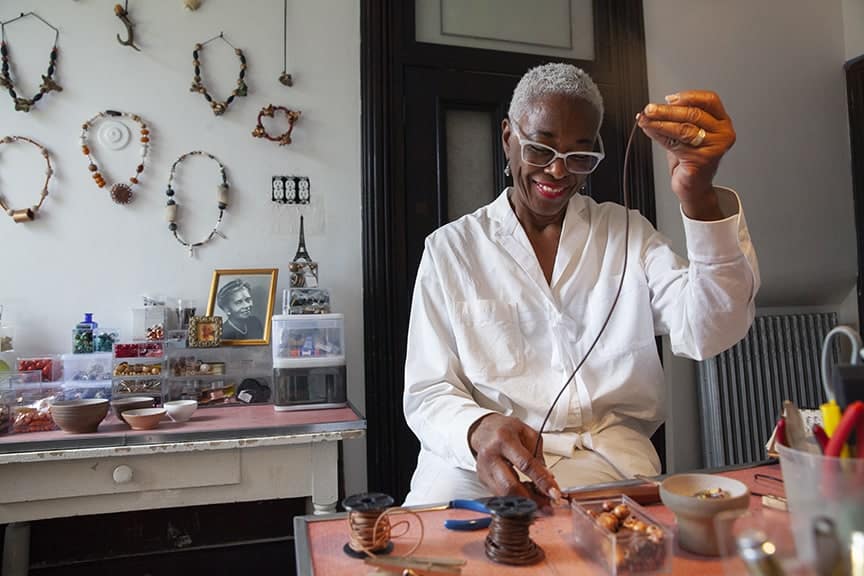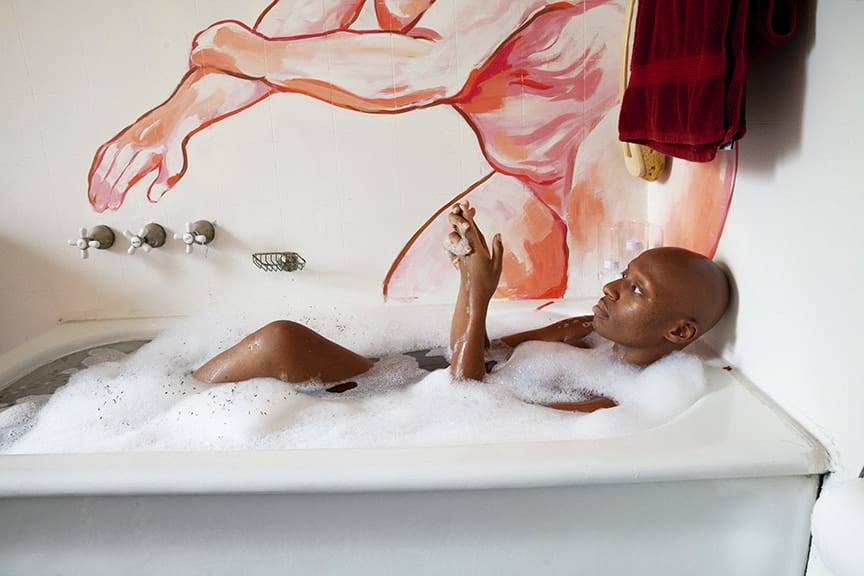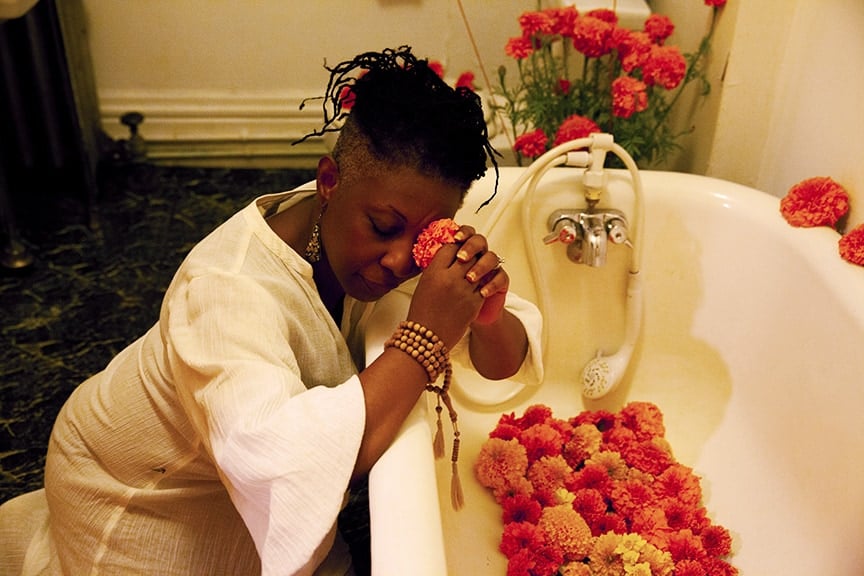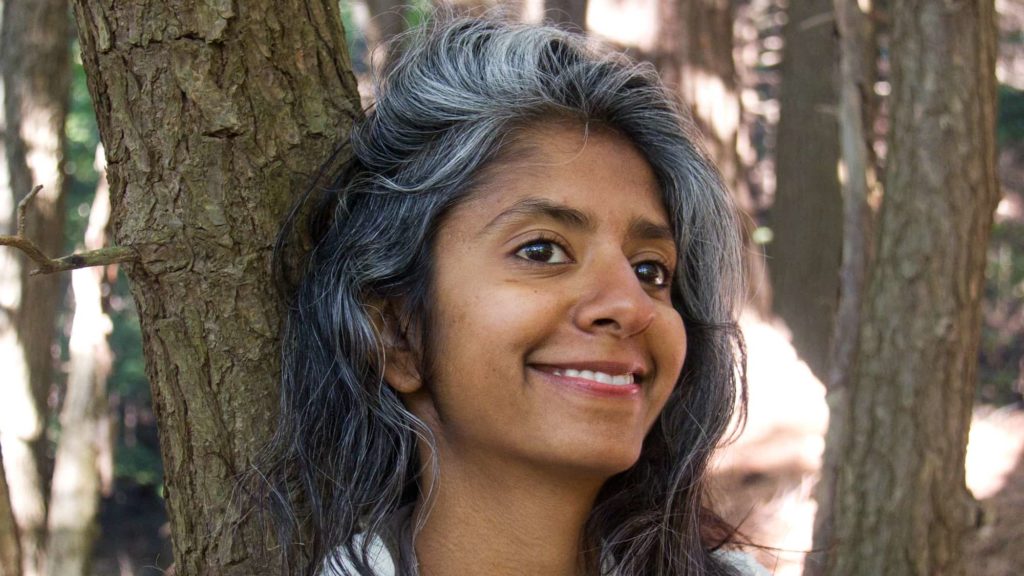Women have come from around the country to perform here tonight. Half an hour ago they were moving across the lawn around the old brick house, getting ready, forming circles, walking on the grass. Now a woman in dark red robes, rose and ochre, laughs and embraces a man standing beside me. I’m standing in line, waiting for Rites of Passage to begin.
65 artists have been working for more than a year to create this performance at the Whitney Center for the Arts. Musicians, visual artists, writers, healers, with work in many forms and places, from Bread and Puppet to the Smithsonian. Through music and theater, color and touch and scent, they are turning the house into a ritual … and a refuge. They’re making it a place where women can move freely. And I’m wondering how it will feel to walk in.
I’m standing with four people who happened to get here at the same time. People will enter in groups, and we know we will be going in together. We’re talking about the alchemy of glassblowing and musical improvisation.
The man beside me knows how much time it has taken to make this show. He tells us his wife is one of the artists, and he marvels at the depth and energy they have all put in — he says they have been setting up for a week, running for twelve-hour days, transforming up the house into a stage and each room into its own performance space — into real living rooms. He says the actors will preform different elements for different groups and different times. The choreography of it feels tidal and immense.

DeeArah Wright and artists from R.O.P.E curate Adolescence in Rites of Passage 2020 Vision. Press photo courtesy of Rites of Passage.
We walk inside, into a hallway with tall ceilings. A woman comes up to us holding a bowl of water and a bundle of green stems. She thanks us for coming in, and we thank her. She dips the leaves into the water, asks each of us in turn and touches us gently on the chest and on the forehead.
I’m thinking English should have words for this balm. We should have more words for an act of giving strength. We should have more than a metaphor to describe this sense — that you are thinking of someone and wanting them to feel warmth. You want to help their mind to clear, a weight to lift, like the air moving at twilight and bringing a scent of thyme. You feel their pain, and even if you can’t ease it, you want them to know you are there, and they are loved, and they are not alone.
And so you walk close enough to touch someone’s private space and ask them to come in. You meet, for a moment. With or without touching, you let them know you are there.
Our host opens a door, and we are walking into the first room. A sign tells us this a space for adolescence. We walk into a front room in an old brick house, and it’s a bedroom with colorful kaleidoscopic drawings on the walls. They are drawings of women, or maybe of the young woman who lives here.
Four women are sitting on the bed, playing a game of Sorry. They are sitting close enough to murmur, and they’re talking too quietly for us to hear. They keep talking, to each other, not to us, four young, gifted and black women and women of color leaning together and laughing softly over the game board.
And so the invitation seems to be to walk into this private place, where they are confiding the way my sister and I used to talk at night when we shared a room, the way we still do when she’s home to visit and we’re in the kitchen after our parents and her children are asleep — the way college students talk at 3 a.m. about the weekend, where they’re going, who they love and how many worlds they can imagine.

Artist and designer Cheryl Riley co-creates the Kitchen in Rites of Passage 2020 Vision. Press photo courtesy of Rites of Passage.
This room makes me think of a dorm room, and maybe it’s the that mix of public and private, the way in college the only place where you could talk with your friends was the room where you slept, and so it became a bedroom and a living room in one, and sometimes the boundaries blurred. A casual conversation could become earnest sometimes as easily as pouring coffee.
And maybe it’s the energy of performance in this space. I remember college as a place where creative energy ran casually down the halls — like the night the a cappella groups came after auditions to sing to their new members, surprising whoever had gotten in, and everyone spilled out into the quad in the September night in a shared boundless elation. This room has that energy. We are looking at a desk, a mirror, a laptop. We’re walking into the space of a teenager becoming woman, into the room where she dreams.
Another door opens, and we walk across the hall and into a room with a large screen, about the only one we will see anywhere here tonight. This room belongs to a poet, a storyteller. She is from Colombia, and the screen is awash with a turquoise blue bay. The room is curated in words and images, and she is talking to us in Spanish, and I turn fully to the screen because I need the captions — I don’t know enough to follow her without the translation.
She is talking about home, recalling a saying … the sea is so calm we can anchor a boat with a woman’s long hair. She is talking about why we are hearing her through a screen and not face to face. Here tonight, every choice feels intentional, and I think I understand that speaking this way feels safe for her. And I think of the pain that leads someone to protect herself in this way, and I am feeling that it is a gift that she will speak, and saddened that she can’t be here tonight, in this space she has worked so hard to help create.
I’m thinking of the ocean, the water clear enough to see the sand of the sea floor, and the devastation of hurricanes. She has a beautiful voice, alto, moving like light on the water. The door opens into the hall again as the film shifts into music, a quick moving beat, a dance rhythm, and I wish we could stay longer, but I’m the closest one to the doorway, and other people will be coming in after us, so I take a folded sheet of paper from a basket offering us thoughts to take with us.
As I walk into the hall, a young woman with long chestnut-dark hair is standing by the stairs to point us into the next room, farther into the house. She looks at me, and I don’t know what she sees. I’m holding the fold of paper with my hands folded close. She puts a hand on my arm, and she looks into my eyes. And I look back. I want to thank her. How rare is it that we look anyone full in the face and hold someone’s gaze? I put a hand over hers, and we stand there for a breath or two. She doesn’t know me, and she is offering me comfort. This is the kind of place you all have made tonight.

Therapist and sustainable farmer / land steward Tashi Colston co-creates the Kitchen in Rites of Passage 2020 Vision. Press photo courtesy of Rites of Passage.
In the next room, the five of us walk into a sanctuary. A woman with a touch of silver in her hair greets us with chimes in her hands. This is a room for womanhood, she says, for motherhood, and the paintings on the walls tell me it is a room for love. In the one above me, two women are holding each other, resting their weight in each other’s arms. The floor is tiled in patterns of rose petals. At the front of the room, vases of roses are blooming in many colors, armfuls of roses. Tiers of roses. They are peach and crimson and yellow and dark pink and fully open.
A door on the inside corner says sustenance, and this small inner room is full of plants — every inch spilling over with fronds and stems and leaves, heady with green. A woman is lying among them, turned away as though she is sleeping, with the light glimmering on her shoulders. I recognize her, because I’ve seen Pooja Prema perform before, and she is the founder of the performance here tonight. I have just time to see her lying quietly, completely still, before the hall door opens and leads us on.
At the foot of the stairs, we find the kitchen door. And it’s a real kitchen in this real house. Three women are sitting at a long red table as though they’re making dinner after a long day. One of them is strumming a guitar, a deep green instrument the color of a jade plant with a curl in the wood by the neck, and she is singing softly about being what you want to be, saying what you want to say. A bowl holds chopped onion, tomato, peppers, avocado. By the hearth a young girl is lying wrapped in a blanket, asleep.
Cheryl Riley, Tashi Colston, Marie Tatti Aqeel and Laura Cabrera created this room together, and I feel wrapped in the warmth of it, standing quietly on the edge of a family making dinner. I’m shaken with memories, growing up, standing in the kitchen at night. I live alone, and it’s an occasional thing now for me to be in the kitchen with someone else, helping my mother put wild grapes through the foley mill, or thawing out last summer’s tomato sauce with an old friend visiting from New Hampshire who taught me to play music by ear.
And I miss it. I’m looking at the room here, the colors of hot peppers and onions on the counter, and the walls are covered with pages loosened from an old encyclopedia and painted over in bright symbols — broad strokes of paint in vivid yellows and reds and greens and oranges. They pulse with color, and they seem to reflect back the conversation and the chords and the feeling of friendship in the room, and I wonder about the language they speak, the meanings they transform. Cheryl Riley creates these Glyphs, turning over ideas of gender and culture and Afro-Futurism. Tonight these three women are creating this space together, as they sit around the table, close enough to talk quietly without waking a sleeping child, and it’s a safe space.

Flamenco artist Sarah Varichon performs Legady in Rites of Passage 2020 Vision
One by one, we file out, and quiet guides point us by gentle touch up the stairs. Percussionists are playing on the landing … Carolyn Koebel, Krista Speroni, Amanda Turk, did I hear you there playing tall drums by hand, rapid and pulsing and uprising as we head up together?
We’re all swaying as we walk. At the top, we are led into a room patterned and shaded in red. A woman lying on the bed turns and sings to us. Juliet Olivier is an artist of Palestinian American descent, a singer and songwriter, actor and dancer. Her voice is clear and carrying and alto, and she is calling to us to care for ourselves.
I remember impressions here. A web of strings holds ribbons of cloth tied like butterfly wings and invites us to add one if we feel it, to honor the pain of someone who has suffered. A group of women formed the Body room together, Tiandra Ray, Shaina Lu, Vivian Ho …
A closet becomes a pantry full of dried fruit and spices and glass jars, and I wonder whether the artists have made these preserves themselves — they’re deep vivid colors, and it’s not easy to hold color in your pickled red pepper or strawberry jam. I’ve never thought of home canning as this kind of art before.
And if you step into the small space, the scents here wrap you round, something savory with heat, not cumin or turmeric exactly, but in that family. There are so many I would not know, the way I had never had coffee black with cardamom and sugar until Ebtisam stayed with me two summers ago, and I have still only read about za’atar. Nadine Zaza chose these. Are they familiar to you, flavors you grew up with the way I picked thyme and sweet cecily?
Another door in another corner leads to a bathroom and a performer in a hot bath with flower petals floating on the water. Devyn Harris, did I meet you there? She is an artist, an activist and a healer working with people who have suffered trauma to their bodies and minds.
Lying in the bath, she touches one dark foot and begins to speak as I come in, looking at the slope of her ankle. She thanks her feet for touching the earth, and for giving stability and balance, even when they are tired. She looks to me as strong and agile as a dancer, recognizing her body, caring for it.

Devyn Harris performs in the Body Room, a healing space in Rites of Passage 2020 Vision. Press photo courtesy of Rites of Passage.
The spaces here begin to open into one another. One room moves more fluidly into another, and we seem to have more time and fewer distinct moments when we have to move on to make room. The group of us come into spaces honoring movement, migration, family and diaspora. Photographs cross the wall, stitched together with red thread, binding one woman’s heart to another. One of the artists has offered a black and red gown that belonged to her Palestinian grandmother.
In a room with a wall of windows a woman is lying on earth, bound about the waist with red cloths that join her to a wide shape on the ceiling like overlapping petals, and she reaches out, letting our her breath in a rhythmic sound like the wind in the dessert.
Sarah Varichon is a flamenco artist who has lived from Honduras and Vancouver Island to Spain and South East Asia to Mexico and learned her art growing up in Granada, Spain, and she has studied and practiced various traditional Mesoamerican healing techniques while living in Oaxaca. She has set lotuses here on tall stalks in vases on the second-story windowsills. I remember reading about lotuses, that they generate their own heat, that they can be a symbol of the divine and of women’s desire.
One room farther in, Nicole Combeau is burying a cord or a root in the soil. She is a photographer, teacher and paper artist from Miami, daughter of Colombian immigrant parents. Aren’t there places where a mother will bury a child’s umbilical cord, so some part of them will always have a hold in the ground where they were born? Movement feels like an ache here, childhood and adulthood and age drawn apart. I remember shapes like the base of oil lamps … photographs of empty shoes in a stone courtyard.

Azaria Carolynn Ulmer, healer, dancer, holds a marigold in her room for Forgiveness in Rites of Passage 2020 Vision. Press photo courtesy of Rites of Passage.
We’re in the upstairs hall, and Sokhna Heathyre Mabin walks in from windows that open onto the roof — it looks as though the roof is covered in short grass, an upper lawn. She talks about maturing in her body, keeping flexibility, keeping strength. She talks to us as she steps back into the outer air, and I watch her, listening, until she clasps her hands and falls quiet. Attention seems like the least we can give tonight. I keep wanting to thank people, to acknowledge their power without shaking their concentration.
We’re in a collage of rooms here, small spaces opening off to the sides. Our group begins to drift apart as some of us spend more time in some places, some in others. I’m reading a poem on the wall, wanting to take all the time I can to absorb all the detail people have layered into this space with so much care, as long as I’m not taking time away from the next wave coming after us.
Here is a room full of photographs, transparent with the light coming through. They are labeled with loss, as though all of them are people someone has had to leave behind, or people who have died. The photographs move from black and white to color, as though they are moving forward in time, and they hold many people, many senses of home.
Here is stairway upward in light and shadow, referencing death. Here is a sheaf of staghorn sumac with a scent of lemon, and here a closet painted in dark as a northern sky and set with constellations of glass beads. Here is a temple to forgiveness, a room full of marigolds, and Azaria Ulmer invites us to take a few minutes to sit with the idea, asking us to think about forgiving ourselves. I meet my eyes in a mirror and wonder how that feels. Here Amanda Castillo touches up her thick curls and gives herself an encouraging talk about celebrating her own beauty in the face of a world that tries to deny it.
And here … a whole wall of books, bright and colorful deep as a meadow — Octavia Butler’s Wild Seed, Toni Morrison, fiction and nonfiction and poetry, Joy Harjo … and I wish I could sit here just to read. Pooja and Charisse Madlock, you both who curated the library, would you tell me again who they all are, so I can look for them?

Pooja Prema brings together Rites of Passage: 20/20 Vision, a large-scale collaborative art and performance project.
One from my original group is still here, though people have come in behind us, and we move together into the Elders Room. I recognize Amber Chand and Satyena Ananda, because they have been active in the Berkshires for so many years, and I’ve been a journalist in the Berkshires long enough to know about Starseed and about Amber’s one-woman performances. They ask us about the evening, and about our ancestors.
We talk about the excitements of being an elder, having freedom, thoughts to give, no one to impress. Their room is filled with paintings and color. They say they want to show the vividness of aging, not any kind of drabness.
The two of us move together from them into a room of dissolution. Desiree Mwalimu-Banks tells us it is a place to let fear and anger go, to put pain to rest. Bees are climbing up honeycomb on the drawings and prints on the walls. She says that bees are psychopomps, to guide souls, or maybe dreams.
We come down the stairs again and into a long room where a woman sits on the wooden floor, weaving. She seems to be working a piece by hand, and I think of the twining technique a local weaver told me about last winter, a portable form you can weave by hand, working one fiber around the warp threads, without a loom. In front of her, two long strands of weaving stretch across the length of the floor in deep rose colors, and alongside them ceramic jars are set out holding water.
A performer greets us and welcomes us into to walk through the room … and think about how many words this V shape could invoke for us right now. Vessel. Voice. Vertices. Vibrant and vivid and vast.
She invites us to write down a thought, if we want to share one, and tie it into a growing mobile of thoughts, and to think about our own rites of passage. And I ask myself when my life has changed, when I have made choices, when I have come to a time that matters. What does it take to come to a time like that. I write a word of thanks, and I walk out quietly into the warm night.

